- Home
- Maurice Magre
Lucifer
Lucifer Read online
Lucifer
by
Maurice Magre
Translated, annotated and introduced by
Brian Stableford
A Black Coat Press Book
TABLE OF CONTENTS
Introduction 4
LUCIFER 14
THE NIGHT OF HASHISH AND OPIUM 224
FRENCH SCIENCE FICTION & FANTASY COLLECTION 275
BY THE SAME AUTHOR 283
Introduction
This is the seventh volume of a twelve-volume set of translations of Maurice Magre’s prose fiction. It contains translations of the novel Lucifer (1929) and the novella La Nuit de haschich et de l’opium (1929), as “The Night of Hashish and Opium.”
Volume One, The Marvelous Story of Claire d’Amour and Other Stories, contains translations of early short stories, including the collection Histoire merveilleuse de Claire d’Amour suivie d’autres contes merveilleux (1903) and six other stories from various sources, published between 1901 and 1913.
Volume Two, The Call of the Beast and Other Stories, contains translations of his first three works of prose fiction in volume form, Les Colombes poignardées (1917), as “Stabbed Doves,” La Tendre camarade (1918), as “The Tender Comrade” and L’Appel de la bête (1920), as “The Call of the Beast.”
Volume Three, Priscilla of Alexandria and Other Stories contains translations of the original version of the story collection Vies des courtisanes, first published in Oeuvres Libres 23 (1923), as “Courtesans’ Lives” plus the additional story added to the version published in volume form in 1925, and the novel Priscilla d’Alexandrie (1925), as “Priscilla of Alexandria.”
Volume Four, The Angel of Lust, contains translations of the novella, La Vie amoureuse de Messaline (1925), as “The Love Life of Messalina,” the novel published as La Luxure de Grenade (1926), as “The Angel of Lust,” and the chapter from Magiciens et illuminés (1930) entitled “Christian Rosenkreutz et les Rose-croix,” as “Christian Rosenkreutz and the Rosicruians.”
Volume Five, The Mystery of the Tiger, contains translations of the novella Le Roman de Confucius (1927), as “The Story of Confucius,” and the novel Le Mystère du tigre (1927), as “The Mystery of the Tiger.”
Volume Six, The Poison of Goa, contains translations of the novel Le Poison de Goa (1928), as “The Poison of Goa,” and the prose poems contained in Le Livre des lotus entr’ouverts (1926), as “Lotus Blossoms.”
Volume Eight, The Blood of Toulouse, contains translations of the novel Le Sang de Toulouse (1931), as “The Blood of Toulouse,” and the chapter from Magiciens et illuminés entitled “Le Maître inconnu des Albigeois,” as “The Secret Master of the Albigensians.”
Volume Nine, The Albigensian Treasure, contains translations of the novel Le Trésor des Albigeois (1938) as “The Albigensian Treasure,” and the collection of vignettes “Communication avec la nature” from La Beauté invisible (1937), as “Communication with Nature.”
Volume Ten, Jean de Fodoas, contains translations of the novel Jean de Fodoas: aventures d’un Français à la cour de l’empereur Akbar (1939) as “Jean de Fodoas” and the chapter from Magiciens et illuminés entitled “Le Mystère des Templiers,” as “The Mystery of the Templars.”
Volume Eleven, Melusine, contains translations of the novel Mélusine, ou le secret de solitude (1941) and the collections of vignettes “Le Côté d’ombre des âmes” and “Révélation des mondes invisibles” from La Beauté invisible, as “The Dark Side of Souls” and “The Revelation of Invisible Worlds.”
Volume Twelve, The Brothers of the Virgin Gold, contains a translation of the novel Les Frères de l’or vierge, first published posthumously in 1949.
After a sequence of exotic historical fictions, which had made gradual progress from the fifth-century Alexandria of Priscilla d’Alexandrie and the Imperial Rome of La Vie amoureuse de Messaline to the nineteenth century settings of Le Mystère du tigre and Le Poison de Goa, Maurice Magre’s fiction returned to the present day in the two works of fiction he published in 1929, Lucifer and in La Nuit de haschich et d’opium; in the former—which was not necessarily written earlier—he also returned after a long gap to contemporary Paris, the setting of Les Colombes poignardées and L’Appel de la bête, and the focal point of the reminiscences contained in his two volumes of autobiographical reflections, Pourquoi je suis Bouddhiste [Why I am a Buddhist] (1928), and Confessions sur les femmes, l’opium, l’amour, l’idéal, etc... [Confessions regarding Women, Opium, Amour and the Ideal, etc.] (1930).
In fact, like L’Appel de la bête, which similarly has a first-person narrator who never reveals his name, Lucifer reads as if it were a kind of confession, and although it is very obviously fictitious, exploring a demonic possession consequent on a casually-made diabolical pact—which might or might not be entirely subjective and psychological—it does have marked affinities with the supposedly honest confessions of the autobiographical texts that bracketed it, in which it is similarly unclear as to whether the various supernatural agencies detailed therein are purely metaphorical and symbolic, the narrators remaining profoundly uncertain as to their objective reality.
Although the existential circumstances of the narrator of L’Appel de la bête were not those of the author at the time he wrote it, and the events of the plot are clearly fictitious, there is an obvious temptation to read those invented events as a superficial disguise permitting the author to contemplate and examine certain real feelings that he had. Confessions certainly endorses that view; there too the author speaks about the sensation that there were two selves competing within him, one an inferior self obsessively orientated carnal pleasure, whose sexual obsession was akin to a form of possession, continually undermining a relatively intellectual superior self interested in spiritual and intellectual development. Certain specific incidents in the narrative of L’Appel de la bête are also akin to anecdotes related in Confessions, not in the sense that they reproduce them straightforwardly, but in the sense that they seem to be reflecting on the lessons to be learned therefrom.
Given that, it is tempting to regard Lucifer as a kind of continuation of the literary and psychological exercise begun in L’Appel de la bête, similarly indulging in reflections, albeit considerably more melodramatically, on matters that would be discussed in a more sober fashion in Confessions. To some extent, it undoubtedly is such a continuation, and in that regard, its near-hysterical extrapolation and exaggeration of the motif of demonic possession introduced in the earlier novel offers an intriguing insight into the psychological ground that the author had covered in the intervening nine years. Those were years during which his amorous adventures had been severely curtailed, when he was diagnosed with syphilis, occasioning a permanent change in his attitude to his inferior self. In Lucifer however, that troublesome personal conflict is set in a broader historical context, the malignity of the possessed inferior self being hypothetically mirrored on a much larger scale in organizations of worshipers of evil whose objects of adoration are capable of supernatural influence.
Magre had broached that notion before, most explicitly in La Luxure de Grenade, where the Spanish Inquisition becomes just such a organization, sending assassins to murder philosophers, although its central Antichrist, Tomas de Torquemada, convinced of his own twisted virtue, seems unaware that he belongs to the Devil’s party. In Lucifer it appears to be assumed that the quest to eliminate the virtuous opposition has been successful; the Rosicrucians and their kindred virtuous organizations have not merely been driven into hiding, but they seem to be extinct, leaving the narrator with nowhere to turn for spiritual succor except the Church—which proves, as might be expected, to be at best impotent, and at worst in tacit alliance with the forces of evil. The narrator is, in consequence, forced to find his own way
out of his predicament, if he can—but that was certainly a conclusion that Magre reached in his life, all of the later works of fiction and non-fiction published in his lifetime being insistent on the fact that every individual has to find his own way to spiritual enlightenment, based on personal experience of contact with the divine.
As a philosophical novel, Lucifer has a certain amount in common with Joris-Karl Huysmans’ classic novel of contemporary Satanism Là-Bas (1891; tr. as Down There), which must have been one of its models. Like Huysmans’ novel it features a climactic “black mass,” albeit one addressed to a pagan deity rather than to the Christian Devil. However, Huysmans’ hero and alter ego Durtal finds a refuge within orthodox faith that the narrator of Lucifer tries out and finds utterly vain, forcing him to orientate his efforts in a different direction. Durtal’s involvement with Satanism is also primarily and quintessentially scholarly, a derivative of his escapist Medieval studies, and of a particular fascination with the personality of Gilles de Rais. Unlike Magre however, who had a strong scholarly interest himself in the Middle Ages, the narrator of Lucifer only pretends such an interest, and thus has no such intellectual refuge. He is entirely focused on the present day, and on his amorous projects, and is unable to take any real interest in the obsessive historical and philosophical research of his bête noire Kotzebue, whose academic pursuit of the legend of Simon Magus enables him to give form to the ritual that he wants to enact, partly and perhaps entirely in pursuit of his own amorous objectives.
That difference might seem surprising, but it is less so when one considers that the particular historical figures in which Magre took an intense interest were Messalina and Isabelle de Solis, and that those he invented, such as Priscilla of Alexandria and the various heroines of Vies des courtisanes, were all variants of the archetypal femme fatale modeled at the very beginning of his career in Claire d’Amour. In Lucifer, the central element of the narrator’s perceived predicament is his obsessive pursuit of two half-sisters, who divide the attractive aspects of female beauty between them, one essentially carnal and the other, at least ostensibly, pure and entirely orientated toward spirituality. Insofar as the novel is exploratory and experimental, it is an examination and evaluation of that duality. To the extent that the analysis in question reaches a conclusion, it is deeply and poignantly frustrating, although—in fact, because—it is evidently and painfully honest.
Partly in order to supply a sense of conclusion that its central analysis cannot provide, the story told in Lucifer is supplied with an epilogue that steps outside the main narrative and reveals that narrative to be the confession of one “J.N***”—which any reader familiar with Magre’s earlier contemporary fiction would unhesitatingly decode as Jean Noël, the poet featured in four of his Paris-set narratives, who seems in those works to be a fictitious device enabling the author to take a wry look at his himself, sometimes in parallel with an unnamed narrator who also seems to be a stand-in for the author. The decision made in Lucifer to obscure the name, while leaving its interpretation obvious, at least to cognoscenti, is odd, and it is not obvious why the author did it. It might be simple playfulness—there was always a playful element to Magre’s creativity, even when he was at him most intensely earnest—but it might also reflects a genuine uncertainty as to the extent of the identification that the author wanted to make with his character, and with the existential situation in which the narrator finally, winds up as a result of his tortuous endeavors.
Seen simply as a story, perhaps Lucifer does not reproduce the full force of the colorful flamboyant melodrama of such historical romances as Priscilla d’Alexandrie and La Luxure de Grenade. In dramatic terms, even the climactic black mass might seem somewhat weakened in its plausibility by its contemporary setting, less dramatic than the mass of Saint Sécaire featured in the later historical novel Le Trésor des Albigeois. If that is the case, it would not be surprising that having got through the retrospective self-analytical phase represented by Pourquoi je suis Bouddhiste, Lucifer and Confessions Magre made a swift return to gaudy historical romance, in no uncertain terms, in the brilliantly extravagant Le Sang du Toulouse. Within the context of the phase of intensive self-reexamination, however, Lucifer is a very striking exercise in transfigurative symbolism, and as an intimate horror story it functions very well indeed—considerably better than L’Appel de la bête. As an account of metaphorical possession, it is detailed with a persuasive conviction, and if one regards its essential purpose as that of sowing a discomfort in the reader’s mind similar to one experienced by the author, albeit exaggerated by poetic license, it certainly succeeds, aided rather than undermined by its protagonist’s ultimate frustration. In its own terms, therefore, the novel is a fine and memorable piece of work, as well as a very unusual one.
La Nuit de Haschich et de l’Opium, set in India, is a far more conventional narrative than Magre’s two previous works of fiction set in the Far East, Le Mystère du tigre and Le Poison de Goa. Like the latter novel, it begins by placing its female protagonist in danger of rape, but the tone and manner of the story are completely different. Unlike Rachel Jehoudah in Le Poison de Goa, the narrator of La Nuit de Haschich et de l’Opium is extremely naïve, and takes an implausibly long time to accept the realization that she has walked into a trap, in spite of receiving all manner of supernatural and explicit warnings. Thereafter, the narrative unfolds is a conventional manner, in spite of its bizarre magical and hallucinatory trappings, and deliberately embraces exactly the kind of stereotyped conclusion that Magre usually made it a point of principle to avoid, making the story a striking anomaly within his canon in that regard.
The novelette was first published by Ernest Flammarion in 1929, and was probably commissioned by its editor, but that does not explain its determined, albeit doubtless ironic, conventionality. La Vie amoureuse de Messaline had probably been written to commission in the same way, but there is nothing conventional about its elaboration and its depiction of the conclusion already specified by legend. Superficially, at least, La Nuit de Haschich et de l’Opium looks more like hackwork than any other work of fiction Magre signed, recycling erotic elements from “Bagawali” (in Vies de courtisanes) and the full-length version of Priscilla d’Alexandrie, as well as making much of the hallucinatory effects of opium.
In the latter regard, La Nuit de Haschich et de l’Opium has obvious affinities with Le Mystère du tigre, collaborating with that predecessor in subjecting the effects of opium to a quasi-clinical re-examination, a decade after Magre’s first literary examination of the drug’s effects, carried out in Les Colombes poignardées and La Tendre camarade. It seems probable that, from the viewpoint of both the commissioning editor and the commissioned author, the plot of the story was merely a container, casually contrived for the convenient representation of the effects of opium—here combined with hashish—and the associated pontifications of the philosophically-inclined Rajah, who is less enslaved to his carnal appetites than his competitors in the scabrous game of cards that supplies the fulcrum of the plot.
As in Le Poison de Goa, the strength of the La Nuit de Haschich et de l’Opium is as much in the setting as the plot, and perhaps more so. The temple of Chillambaram featured in the story is fictitious, but is obviously based on reports that Magre had read of the actual temple-complex of Chidambaram, removed from the city of that name into a different and more isolated location for the convenience of the narrative. It is easy to understand why Magre would have been impressed by a description of Chidambaram’ five Shiva temples, and the symbolism of the incarnation of the elements in their five lingams; in its gaudy exoticism, however, his Chillambaram is very much a product of his own imagination, especially when it is transmogrified by the imagination of the hallucinated and terror-stricken heroine.
Whereas the hallucinatory effects of opium on the anti-hero of Le Mystère du tigre seem to assist in his redemption, however, they are purely problematic for the hapless narrator of La Nuit de Haschich et de l’Op
ium, and that probably offers a more accurate account of Magre’s final judgment of the drug than the nostalgic reminiscences of Confessions, which deliberately attempted to return to the mind-set of his early experiments, and to explain his initial hopeful enthusiasm for opium-smoking. Although calculatedly trivial, therefore, the novelette is not without interest in the context of the author’s work as a whole, and if viewed in isolation it does have a certain depth behind its obvious artificiality and its breezy fluency. At any rate, it provides an interesting frivolous counterpoint to the earnest intensity of Lucifer, and might have been written with that purpose in mind, as an item of light relief from intense introspection.
The translation of Lucifer was made from a copy of the 1929 Albin Michel edition of the book. The translation of La Nuit de haschich et de l’opium was made from a copy of the reprint published in Pondicherry in 2009 (as Nuit de haschich et opium) by Kailash.
Brian Stableford
LUCIFER
I almost uttered a cry of surprise. The coaching entrance to the small house, the two symmetrical illuminated windows and the plastered wall with its coiffure of tiles represented an enormous and bizarre face looking at me.
It’s a warning, I thought.
And I strode back and forth with satisfaction along the sidewalk of that solitary street in Passy without worrying about what the nature of the warning might be. My appetite for mystery was so great that I populated the world with enigmas, not in order to solve them but in order to delight in marveling at them.
I darted a further glance at the house, and perceived to my surprise that the crude representation of a face had been modified, and resembled another image, also created by a secret society, at the time of my twentieth year.

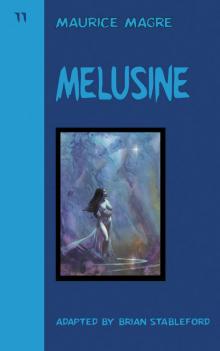 Melusine
Melusine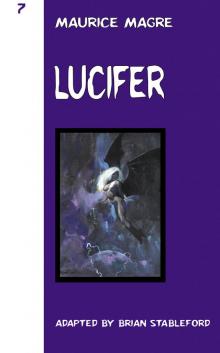 Lucifer
Lucifer Jean de Fodoas
Jean de Fodoas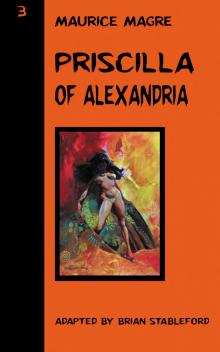 Priscilla of Alexandria
Priscilla of Alexandria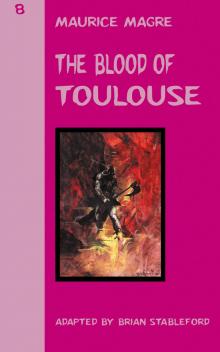 The Blood of Toulouse
The Blood of Toulouse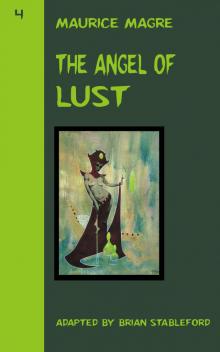 The Angel of Lust
The Angel of Lust